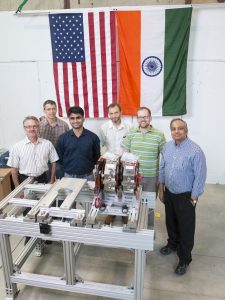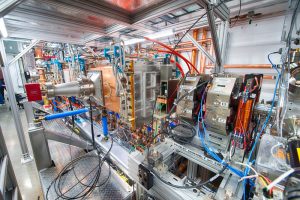
They stand by their work: PIP-II collaborators stand next to the doublet magnet, built by BARC, for the PIP-II medium-energy beam transport. From left: Michael Tartaglia (Fermilab), Joseph DiMarco (Fermilab), Vikas Teotia (BARC), Alexander Shemyakin (Fermilab), Curtis Baffes (Fermilab), Shekhar Mishra (Fermilab). Photo: Reidar Hahn
Building particle accelerators for high-energy physics is an international affair, and Fermilab’s future PIP-II accelerator is no exception. Week in and week out, two teams of accelerator scientists and engineers two oceans apart work to design and produce components for two future machines, one in India, and one at Fermilab.
The partnership recently bore its first, tangible fruit: preproduction magnets designed and built at Bhabha Atomic Research Centre (BARC), in Mumbai, India. The magnets were installed and tested at the Fermilab PIP-II Injector Test Accelerator in late March.
The installation of these magnets – four quadrupole focusing lenses and two dipole correctors – is just the start of an important collaboration with BARC on PIP-II, drawing together research groups from opposite sides of the world.
Since January 2015, the two laboratories have been regularly accommodating the half-day time difference, making late-night or early-morning conference calls, to realize dreams of two countries for high-power accelerators.
“BARC has really stepped up in taking the responsibility for designing and fabricating these magnets, delivering them in a timely manner,” said Shekhar Mishra, deputy project manager for PIP-II. “We gain a great deal from the partnership with Indian laboratories, which is critical to the success of our accelerator-based physics program.”
More BARC magnets will find a home in a section of PIP-II called the Medium-Energy Beam Transport (MEBT), through which a beam of negatively charged hydrogen ions will travel at 2.1 million electronvolts. BARC is building a total of 16 dipole and 34 quadrupole magnets, which will guide and focus the particle beam.
BARC rigorously tested the first set of magnets for their magnetic, electric and thermal qualifications, making sure they met PIP-II specifications before they delivered them to Fermilab, where both BARC and Fermilab scientists tested them once again.
The magnets worked as expected. The beam, guided by the magnets, went through the first portion of the MEBT with no measurable losses.

BARC’s two preproduction quadrupoles (with labels B and C) and dipole (with the copper winding) for PIP-II are visible toward the right of the picture. Photo: Reidar Hahn
The collaboration between BARC and Fermilab extends well beyond accelerator magnet development to include all key areas of the PIP-II Superconducting Linac. BARC scientists and engineers – many of whom are young, early-career scientists – have wide-ranging skills that dovetail with Fermilab expertise in superconducting radio-frequency technology, on which most future high-energy accelerators are based.
“This will help us gear up for meeting future challenges,” said Sanjay Malhotra, subproject coordinator at BARC for the Indian Institutions and Fermilab Collaboration. They include developing components for accelerator applications in Indian industry.
BARC plans to send the next batch of magnets in July and finish the delivery by the end of 2016.
The Fermilab-BARC partnership is part of the umbrella Indian Institutions and Fermilab Collaboration, which Mishra helped establish. The IIFC works with the U.S. Department of Energy to develop research facilities at Fermilab and accelerator projects at Indian Department of Atomic Energy (DAE) laboratories. Thirteen subprojects at Fermilab are conducted under the aegis of IIFC, and all are on schedule.
“Thanks to the excellent support and vision of the management and international coordinators at DAE and Fermilab, our collaborative programs have been running quite smoothly,” Malhotra said. “The technical teams on both sides have worked diligently to ensure that the collaboration runs seamlessly on both sides.”



